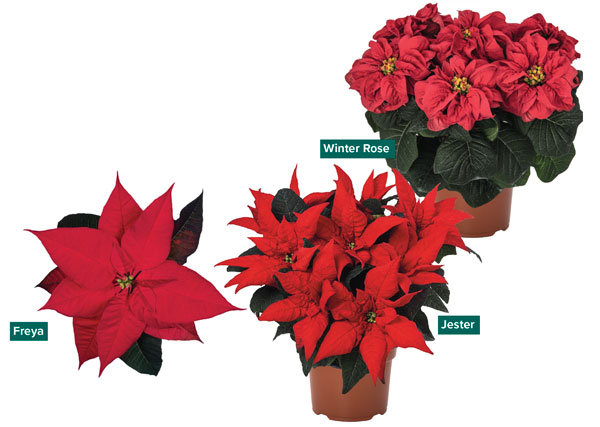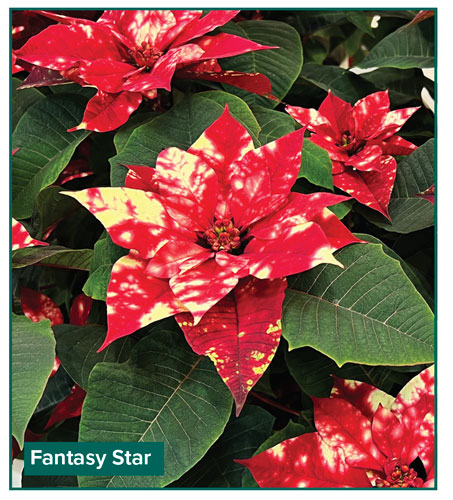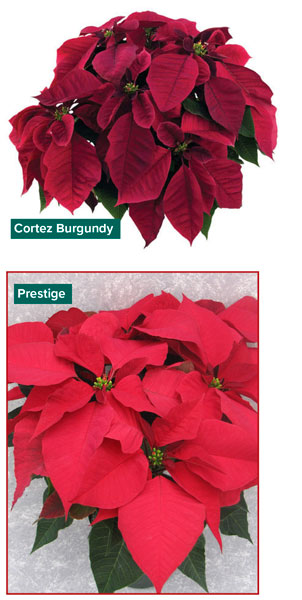5/1/2024
The Best Poinsettia for …
Chris Beytes

There are more than 200 poinsettia varieties on the market to choose from, including more than100 reds. They’re all good—but which ones are best? To find out, we asked experts Rebecca Siemonsma of Express Seed, Gary Vollmer of Selecta One and Steve Rinehart of Rinehart Poinsettias to take off their company hats and tell us, objectively and honestly as they could, which varieties, regardless of breeder, are the very best in a wide range of categories. Here’s a brief excerpt of their answers.
Best for the earliest plants at retail
Steve Rinehart: “Christmas Magic, Early Orion, especially as you go south. Advent. Those are some early candidates. And I should throw in my own Ranch Red just to cause a little stir.”
Rebecca Siemonsma: “I’m going old-school with Advent. Reliable, that’s the earliest with color. And Dümmen Orange has a new one called Rapid Red that’s showing a lot of promise.”
Gary Vollmer: “Historically, Advent, without question … but right now, the one we’re comfortable hitting Week 45 all day with is Christmas Magic.”
Best for autumn/Thanksgiving
Gary: “Autumn Leaves is a spectacular color … a challenging variety to produce, but the uniqueness of the color and the retail appeal of that color makes it one that growers are figuring out how to produce.”
Steve: “I completely agree with Gary … Autumn Leaves was a breakthrough.”
Rebecca: “Autumn Leaves for me, too, because while we have seen some other oranges that time early now, sometimes under retail lights, consumers don’t know if it’s a shade of red or an autumnal color.”
Best for pixies/minis
Rebecca: “There’s a new series from Dümmen Orange called Freya. It’s really great for minis. It’s got a cute little habit, cute little bracts, lots of colors to choose from.”
Gary: “Our top mid-season is Christmas Beauty. We also use Christmas Glory, a low-vigor variety. We’re also seeing a lot of uptick on Christmas Eve—high-density, a smaller bract, it’s also clean-stemmed without a lot of underbranching.”
Steve: “I see a lot of Freedom still around in Europe; they seemed to have discovered Freedom later than the U.S. I see Christmas Beauty, as well. And with Freedom you can dip that temperature late in the season and hold it really well.”
Best for cut flowers
Steve: “Oh yeah! I’d bring back the retro and it’s Renaissance. Without a doubt. I love that plant! You talk about a long-lasting plant. In a tub on the doorstep in California it lasts for four months. I’d grow large pots that are cut at retail.”
Gary: “I would say that Valentine, Winter Rose, those types. Their vase life is very good. The issue really is the yield they can produce; the cost per stem is going to put them up there with an orchid spray or something—a very high-value stem. I love the concept and we talk about it annually with the breeder, but we can’t get anybody to bite on the cost or production.”
Rebecca: “Jester. Jester is such a cool cut flower. Any poinsettia will work, but Jester has kind of a special, unique look to it. There’s a resurgence in domestic-grown cut flowers, so there’s a place for them. And there are a lot of garden centers that have flower shops. It’s not going to be a huge market, but there is interest.”

Best for the pickiest florist customer
Rebecca: “There’s one called FabYULEous from Dümmen Orange. Just like IGCs, the florist market wants cascading bracts, that sort of blueish undertone to the red color, big cyathia.”
Steve: “I’d stay with the large cyathia, florist-grade—I’d have the same choices of Ranch Red and Legacy.”
Gary: “Christmas Wish sizes up with a big bract. It has that traditional look.”
Best for churches/fundraisers
Steve: “There are a lot of choices, but Mirage isn’t a bad choice. I think a lot of Prestige is still grown, as well.”
Rebecca: “I like Grande Italia for the church market. It’s a big plant, for a large 6-in. or 8-in. And the color is good—you have to think about the red under retail lights versus the church setting, and for me, that variety looks really nice in that market.”
Gary: “Grande Italia is one they grow in Italy for the Vatican because there’s not a lot of light in the basilicas between services except what comes from the stained-glass windows. When you are in that dark setting, that’s where Grande Italia shines and it holds its color.”
Best for the landscape market
Steve: “I call it the 306—a jumbo six-pack transplanted into outdoor beds. Traditionally, Advent was used in that arena. I think Ranch Red because it is resistant to rain and all the elements. So Advent or Ranch Red.”
Rebecca: “For me, Advent or Ranch Red because they do work well in the landscape. If St. Louis was still around that would be the true landscape variety, but I don’t know if anybody has any St. Louis cuttings anymore.”
Gary: “In a pack, Advent is the standard. But I do think there is interest in producing a bigger-spec feature plant for the landscape purposes. Back in the 80s during my Natural Beauty time, we grew 6-in. pots of V-10 Amy for Disney for the landscape.”
Best for no PGRs (naturally compact)
Gary: “Gotta go Kayla. Kayla is a beautiful variety that’s really naturally compact, has a good color.”
Steve: “I agree with Kayla, but I’d also add Pepita. It stacks up the leaves really tight. It’s used in Europe for that same reason.”
Rebecca: “Kayla for sure, just for the natural compactness. But I would also add Viking Pro. You want to choose a variety that doesn’t produce a lot of lower laterals too readily and profusely because that’s where the need for early PGRs comes in.”
Best for red/white combination pots
Gary: “Our top red/white—and we have a lot of the market with it—is the Joy family, Joy Red and Joy White. It’s our anchor in that arena.”
Steve: “Lazzeri has done a great job in that category, so take your pick from them. But also, traditionally, Red Glitter that Ecke had is not the most bright, but the strength of that plant is not to be left out.”
Rebecca: “I like Joy for early, that’s really the standard for early combos. But if you need late, Leona from Beekenkamp is a good option.”

Favorite “oddball” novelty
Gary: “Right now, my favorite oddball novelty is Autumn Leaves. Just because the color has so much power and it’s a true novelty because it’s multi-shaded. But what we are launching is Sky types—red bracts with white spots, very much like a Sky-type petunia. They’re all sports from a grower in Germany … we’re doing a bunch of cultural regimes so we can figure out how to actually manage [the pattern].”
Steve: “There is a plant called Fiesta Sunrise that’s not on the market that has gotten me so much attention. It’s a gold with jingle. The marketplace really responds to it and I get requests all the time, but we really can’t produce it.”
Rebecca: “I love Christmas Mouse. I think it’s so cute!”
The poinsettia you wish you had bred
Rebecca: “Kayla from Beekenkamp. Hands down. I think it’s really a fantastic variety. It’s beautiful, it works in all regions, it’s really versatile.”
Gary: “Absolutely, without question, Kayla. It won’t work for 10-in., but it will run the gamut of all medium and small pot sizes, the timing, the dark red color, the good-looking bract—all of that checks a lot of high-priority boxes.”
Steve: “Through history there have only been a handful of varieties that have risen to the dominant-volume category. That was Hegg in its day, that was Freedom, that was Prestige. In today’s world, what is that variety? I think Christmas Beauty is headed toward that high-volume category. So I’d say Beauty.”
An old variety you’d like to bring back
Steve: “I’d go back to Renaissance. And if I can pick a second, it would be Visions of Grandeur.”
Rebecca: “I like a variety called Solstice, which was late, from the Ecke assortment. And Chianti—I love it, also.”
Gary: “I’m going back to the revolution of Hegg Top White. It was a radical breakthrough variety in the fact that it branched and it was the whitest thing we’d seen up to that point.”

A poinsettia you wish had never been bred
Gary: “Cortez Burgundy. The buyer at Fred Meyer really loved this thing, so we had to grow lots of it, and it was the one we had to write the most credits on at the store. It looked great in the moment, but it would just start to fall apart the minute it left the bench.”
Rebecca: “I would agree with that 100%. It’s one we can’t talk growers through most of the time because it does some weird physiological things.”
Steve: “My original answer was going in the direction of poinsettias that had leaf drop—Angelika, Peterstar … They played a role in the market, but they weren’t the best for post-harvest. But I’m going to change to Gary’s answer.”
The best poinsettia of all time
Rebecca: “I’m going to say Prestige. It revolutionized the expectations of reduced stem breakage … it checked all the boxes. And for me, I learned about poinsettia production the most when we were introducing Prestige.”
Gary: “I can’t argue with Prestige. It revolutionized the concept of habit and durability that we just didn’t think about before. When Prestige hit the market, it raised the bar … it set a standard that we still breed to today.”
Steve: “It’s hard to argue against Prestige—it was a good one, it still is—but Freedom also did that in the generation prior, really took it to the next level, as well. But there was also Red Velvet, and its sports, Autumn Red and Velveteen. In one fancy-grade, florist-quality series we could do early, mid and late timing. It was genius! Oh my gosh. I’m going to make Red Velvet my best.” GT
Hear the entire uncut conversation in podcast form.
Watch the video.